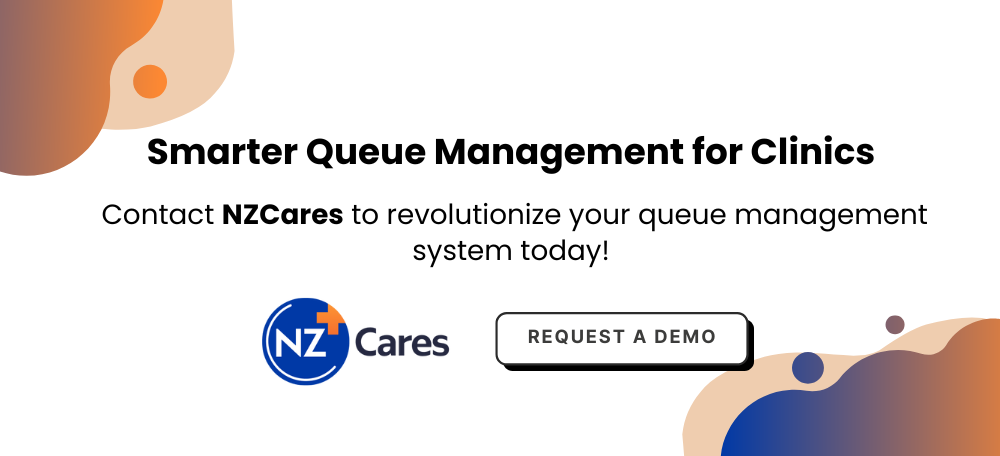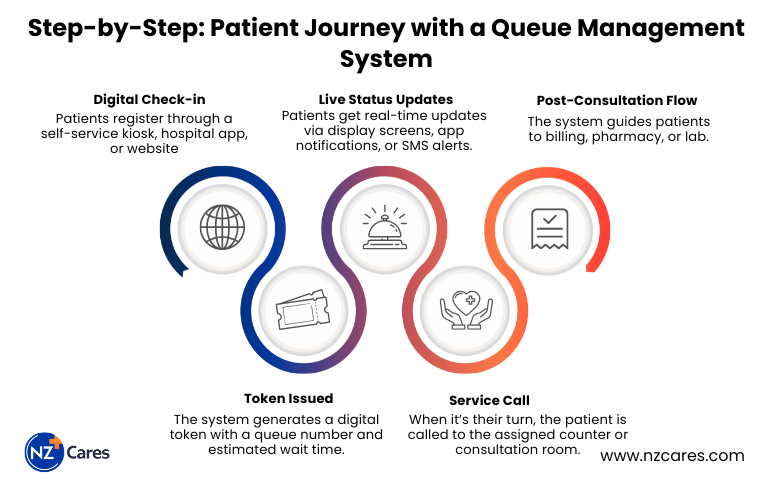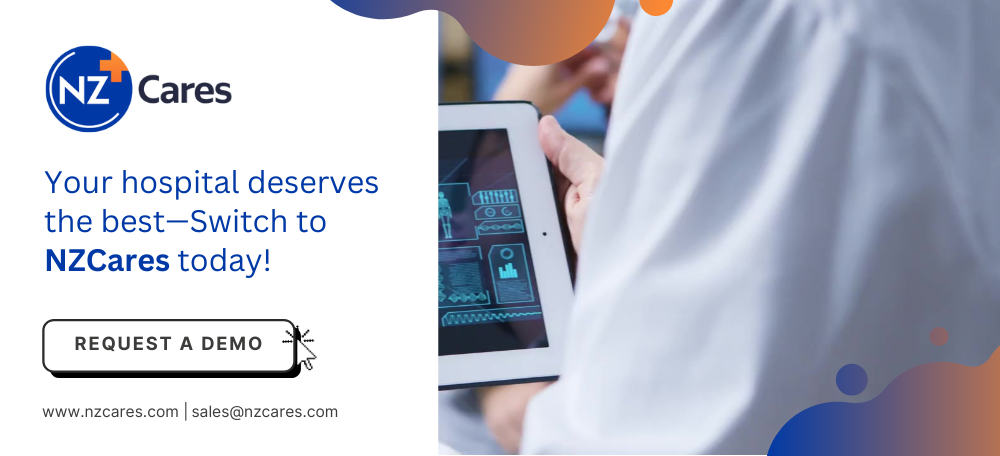Every minute a patient waits in a crowded OPD is a minute of rising anxiety—discover how digital queue management is turning that chaos into calm, one token at a time.
Step into a hospital’s outpatient department, and you might see a busy scene. People crowd the waiting area in which some booked appointments while others walked in. The front desk team scrambles to keep track of everyone, but long waits make patients restless.
A study found that about one in three patients might leave if they’re stuck waiting too long. That’s a big problem for hospitals trying to help everyone.

Hospitals strive to build a calm and friendly space, yet limited staff and resources often make it tough. This strain can turn the outpatient department into a tense place for patients and employees alike, with slowdowns adding to the problem.
Long queues don’t just annoy people, they can cause real issues. When services slow down, patients get uncomfortable, and sometimes their health gets worse while they wait. In the past, messy waiting rooms even led to arguments or confusion that could’ve been avoided with better planning.
The COVID-19 pandemic changed things fast. Rules about keeping distance and limiting crowds forced hospitals to rethink how they manage patient flow management in OPD. A digital queue management system became a lifeline, helping keep patients, staff, and visitors safe while still getting everyone the care they needed.
Now, hospitals and clinics are all about making visits smooth and easy. A hospital queue management system is a big part of how they show patients they care. In this blog, we’ll dig into how these systems tackle the toughest challenges in outpatient departments, making life better for doctors, staff, and patients alike.
What is Digital Queue Management System in Healthcare?
A OPD queue management system in hospital settings streamlines patient flow using digital management. It allows patients to check in via apps or kiosks, get queue updates, and receive reminders, reducing waiting room clutter and improving convenience.
These systems manage high patient volumes by tracking queue length and wait times in real time, helping staff stay organized. A hospital queue management system cuts congestion, letting healthcare providers focus on care rather than chaos, creating a smoother experience for everyone.
The system monitors queues continuously, noting how many patients are waiting and for how long. Patients can join remotely via SMS, QR codes, or apps, making the process flexible and efficient.
Types of OPD Queue Management Systems
-
First-Come, First-Served:
It is used for routine visits like check-ups, patients are served in arrival order. They check in at an app, get a digital token, and the system tracks their place, ensuring a fair and orderly process with staff alerts for the next turn. -
Priority Queuing:
For urgent cases, like critical conditions, patients are prioritized based on medical need. The system assigns priority levels at check-in, moving high-priority patients ahead with real-time staff notifications, maintaining flow for others. -
Appointment Queuing:
For scheduled visits, patients book slots online or via apps. The system confirms their time at check-in, minimizing delays by coordinating schedules, ensuring an efficient visit for patients and staff.
Each type meets specific needs, supporting hospitals to boost efficiency and patient care.
OPD Challenges Resolved by Digital Queue Management System
According to many studies, patients endure waits of 2-6 hours for consultations which waste time for them and staff, who spend 40-60% of their time managing queues. Moreover, 15% of appointments are missed due to poor communication, lowering hospital efficiency.
A digital queue management system addresses these issues effectively.
- Reducing Waiting Room Congestion
Overcrowded waiting areas increase stress and health risks, like spreading infections. A patient queue management system resolves this with virtual queuing through apps or SMS. This clears physical spaces, reduces germ transmission, and frees staff from crowd control.
- Easing Patient Irritation
43% of patients get upset after 20 minutes which can harm satisfaction and reputation of your medical facility. A hospital queue management system shortens delays by streamlining flow and sending real-time updates via apps. This keeps patients informed, boosts their experience, and fosters positive word-of-mouth, critical in healthcare where trust drives choices.
- Enhancing Information Sharing
Waiting rooms often lack clear communication, leaving patients uninformed. An OPD management software uses queue display screens to share updates, like safety protocols, doctor schedules, or health tips. This keeps patients engaged, reinforces hospital standards, and supports a smoother, more satisfying visit.
- Collecting Patient Insights
Without feedback, hospitals miss chances to improve. A queue management system for hospitals gathers reviews and ratings at checkout via digital tools. This direct input helps identify service gaps, ensuring patient voices shape better care and stronger operations.
- Intelligence Decision Making
Lack of insights hinders efficiency. A digital queue management system tracks queue stats, wait times, and staff performance, generating reports on peak hours and trends. Integrating with systems like lab information management systems and EMR, it refine processes, boost patient happiness, and plan strategically.

Key Features of Hospital QMS
A patient queue management system organizes patient flow with practical tools. These features support smoother operations, helping staff and patients navigate busy healthcare settings with ease.
- Appointment Scheduling and Self-Check-In Options: Patients book visits through apps or websites, arriving with less hassle. Kiosks or mobile check-ins skip paperwork, starting the visit efficiently for both patients and staff.
- Real-Time Queue Monitoring: Updates on queue status appear on screens or phones, keeping patients informed. Staff use the same data to manage resources, maintaining a steady flow through the day.
- Patient Notifications and Alerts: Texts or app messages notify patients about their turn or delays. This reduces missed appointments, letting staff focus on care rather than manual follow-ups.
- Staff Assignment: The system assigns staff based on availability and patient needs, balancing workloads. This ensures timely care without overwhelming the team.
- Analytics and Reporting for Process Optimization: Data on wait times and staff performance guide improvements. Reports highlight issues, helping managers refine operations for better patient experiences.
Where Queue Management Shines: Applications in Healthcare
A patient queue management system isn’t limited for hospitals, it helps all sorts of healthcare spots. Here’s how it makes a difference in a different medicare environment.
- Hospitals: Big hospitals see tons of patients every day. These systems keep things organized, help staff work smarter, and make sure patients get seen faster.
- Test Centers: Places that do tests, like for COVID, use these systems to book times and keep lines short. This makes testing quick and safe for everyone.
- Vet Clinics: Even pet doctors use these systems to plan visits for animals. It keeps pets and owners calm by cutting down on waiting room time.
- Labs: Testing labs get busy, but a hospital OPD management system helps patients know when to come and keeps the lab running smoothly.
- Clinics: Small doctor offices use virtual lines so patients don’t have to sit around. They get a text when it’s their turn, which saves time.
- Pharmacies: At the pharmacy, these systems make picking up medicine faster by organizing who’s next, so nobody waits too long.
Every place gets a boost from a queue management system for hospitals, helping both patients and staff have a better day.
How Queue Management Works in Healthcare
A queue management system in hospital settings guides patients smoothly from arrival to care. Using digital tools, a hospital queue management system keeps patient flow organized, cuts wait times, and supports staff efficiency in busy healthcare environments.
- Patient Check-In: Patients start by entering details on a kiosk, app, or website. Name and visit reason get logged, kicking off their hospital journey without piles of paperwork.
- Queue Assignment: A unique number or digital token is given to each patient, setting their spot in line. It sorts them by arrival or urgency, keeping things fair and orderly.
- Queue Monitoring: Screens or apps show wait times and queue updates. Staff see the same, helping them manage the flow and keep the day on track.
- Service Delivery: Alerts via text or displays call patients to their appointment or treatment area when ready, ensuring care happens without delay or mix-ups.
Real-World Impact: Transforming OPDs with Queue Management
Implementing a queue management system in hospital environments brings clear improvements to outpatient departments. A hospital queue management system organizes patient flow, reducing strain and enhancing the overall experience.
- Reduced Patient Wait Times: Patients spend up to 50% less time waiting, getting to their appointments sooner. Missed visits also decrease by 75%, ensuring tighter schedules.
- Improved Customer Experience: Laboratory queues shrink by 15-20%, easing patient frustration. Satisfaction rises, with 80% noting a more pleasant hospital stay.
- Boosted Staff Productivity: Front-desk work becomes 10-15% more efficient, allowing focus on care. Automated notifications lift communication by 70%, simplifying daily tasks.
- Increased Patient Retention: Smoother visits encourage patients to return, with loyalty rising due to better experiences. Facilities see up to 20% higher repeat visits.
Resolve all your healthcare management worries with NZCares
NZCares is packed with intelligent features designed to streamline the patient experience from check-in to check-out. Our solution works in multiple flows to enhance communication and patient experience. It provides real-time status updates, and with seamless integration with other EMR, it works effortlessly. All of this while delivering actionable insights through centralized analytics dashboards. Moreover, it doesn’t end, the solution comes with loads of features mentioned below.
- Intelligent Appointment Routing: Sorts queues by medical urgency and special needs, adjusting in real-time to minimize waits and maintain smooth patient flow.
- Patient Journey Mapping: Tracks every step of a visit with one ID, simplifying management across the entire OPD management system process.
- Notifications & Live Status Checking: Sends updates through WhatsApp or apps, keeping patients aware of their queue position without hassle.
- Service Analytics & Dashboards: Offers data on delays and performance, helping hospitals refine schedules and boost daily efficiency.
- Centralized Control: Unifies tasks in one system, reducing mistakes and ensuring consistent operations across clinics and labs.
- Task Management and Compliance Tracking: Monitors daily activities and aligns with healthcare rules, supporting smooth and lawful operations.
- Instant Access to Prescriptions and Medical Reports: Provides immediate access to patient records, keeping them engaged and informed about their care.
- Virtual Consultations and Telemedicine Integration: Enables remote doctor visits, adding flexibility for follow-ups and quick consultations.
Final Thoughts
Looking at OPD challenges shows just how much a digital queue management system can help. It fixes problems like crowded rooms, long waits, and missed visits, making hospitals run better. With tools like automatic check-ins, live updates, and smart data, these systems keep patients and staff happy. They work in all kinds of places, from big hospitals to small pharmacies, proving they’re super useful.
The results are clear: waits get shorter, patients smile more, and staff work smarter. NZCares takes it even further, offering a full package that brings calm to busy healthcare settings. Choosing a queue management system means less stress and better care for years to come. For anyone wanting to make this change, NZCares is a great partner, with smooth systems and support that make healthcare a breeze.
👉 Contact NZCares for a Demo or visit www.nzcares.com.


